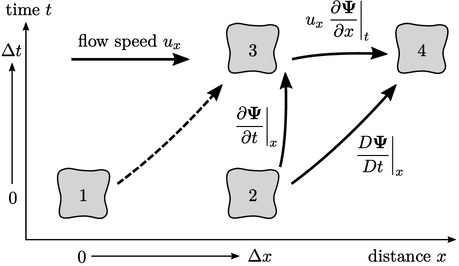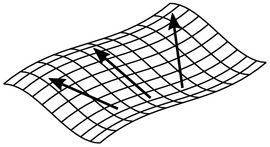2.5 Time derivatives
The conservation of mass Eq. (2.8
) included a partial derivative in
time  relating to a fixed region
of space. This is the local
rate of change of
relating to a fixed region
of space. This is the local
rate of change of  , relating to the
change in
, relating to the
change in  in the fluid measured by an observer at a fixed location. It
is not the time rate of change experienced by a mass of fluid
particles as they move through space. In the same way,
in the fluid measured by an observer at a fixed location. It
is not the time rate of change experienced by a mass of fluid
particles as they move through space. In the same way,  is not the
acceleration experienced by the fluid.
is not the
acceleration experienced by the fluid.
Acceleration relates to the material, or
substantive, derivative
which describes the time rate of change of a fixed mass of moving material. It is
denoted by  and is related to the local rate of change, using
and is related to the local rate of change, using
 as
an example tensor of any rank, by
as
an example tensor of any rank, by
 |
(2.14) |

The relation is derived from the chain rule of differential. In one
dimension, it is illustrated by two particles of fluid that occupy
positions 1 and 2 at some initial time, then positions 3 and 4 at a
later time  . The particles move in the
. The particles move in the  -direction at speed
-direction at speed
 ,
such that the particle at 1 later occupies the position 3 and the
particle at 2 occupies position 4.
,
such that the particle at 1 later occupies the position 3 and the
particle at 2 occupies position 4.
The material time derivative of  , following the mass
from 2
, following the mass
from 2 4, is the sum of: the local change in
4, is the sum of: the local change in  at a fixed position
at a fixed position
 (2
(2 3); and, the change due to the gradient of
3); and, the change due to the gradient of  between positions 3 and
4, fixing time
between positions 3 and
4, fixing time  . This equates to
. This equates to
 |
(2.15) |
Gradient
The last term in Eq. (2.14)
introduces the gradient
denoted by  . If
. If  is a scalar, the gradient produces a vector whose
magnitude and direction is that of the steepest gradient.
is a scalar, the gradient produces a vector whose
magnitude and direction is that of the steepest gradient.

The figure above illustrates the gradient using a surface that represents a distribution of a scalar field in 2 directions. The gradients at 3 locations are in the direction of steepest ascent.
When  is a vector, the gradient produces a tensor,
representing the direction and magnitude of steepest ascent for
each of the 3 components of the vector.
is a vector, the gradient produces a tensor,
representing the direction and magnitude of steepest ascent for
each of the 3 components of the vector.

